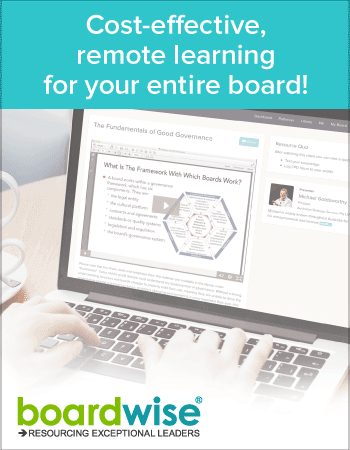What Is a Consent Agenda? Including Template Consent Agenda
-
meetings
What Is a Consent Agenda? Including Template Consent Agenda
Consent agendas, sometimes called strategic board agendas or block agendas, can significantly improve your Board’s ability to make decisions. Having an effective meeting agenda can help Board members prepare, participate, and stay informed and engaged. Not only can they empower the chair to take charge of the meeting and move items along strategically, but they can help organisations avoid unnecessary discussions at a high level.
As a governance tool, the consent agenda consists of grouping together agenda items before a meeting and approving them as a block during it. The approach reduces the time spent on reviewing reports in-person and helps Boards prioritise more important points. By staying focused on strategic rather than the operational, they can stay focused on the why of the organisation and avoid having meetings for the sake of holding meetings.
Most governance experts recommend asking directors to review the consent agenda and share their questions before the meeting to reduce the need for long discussions and refocus attention on regular agenda items that may involve last minute issues such as crisis management.
What is a Consent Agenda?
The consent agenda is used to streamline meeting procedures by placing routine and non-controversial items into a separate block of items that does not require further discussion and can be voted on and adopted. It can be used a governance tool for making board meetings more productive and time efficient. Consent agendas can be included as part of a normal meeting agenda or can be developed as a separate document.
By determining the board meeting agenda, how the discussion question is framed, who gets to speak first, I can make a huge difference to the outcome. I have to use this power wisely for the benefit of the board. ~ Board Chair INSEAD Survey Respondent
The consent agenda can be adopted as a regular practice during board meetings by tabling a motion to adopt a rule of order allowing the process. Ideally instructions on how to use the consent agenda should be provided to all board members as part of the orientation process. It’s purpose is to encourage board members to make space for more in depth discussions and innovation, leaving them available to focus on the most important challenges and opportunities the organisation faces such as identifying new sources of revenue, building the board membership, developing a strategic plan.
To be effective, all members of the board should understand the consent agenda process and have the opportunity to ask questions, in the order they appear on the agenda.
Benefits of Using a Consent Agenda
According to Board Source, the consent agenda can improve not-for-profit governance by focusing meeting discussions on what matters most. Using one can not only save time but also reduce the need for Board members to review routine items, promoting efficiency and good time management. This leaves the group more freedom to focus on important matters and issues.
This form of agenda can improve the board’s ability to collaborate with each other and with partners, pushing members to become more engaged by having them prepare for discussions and review documents before meetings. This can help directors think more strategically and give them time to reflect on their role and how they can better drive the mission, programs, and impact of the organisation.
Consent agendas can make meting facilitation more interactive and animated by focusing conversations on substance rather than structure and repetition. This can leave room for problem solving and creative thinking. Ultimately, using a consent agenda can help board directors perform better by helping them move through menial administrative task. The group is more able to stay in the moment rather than concentrate on past discussions, opening the door for forward thinking and creativity.
What To Include in A Consent Agenda
A good rule of thumb for deciding whether to include a consent agenda item is to ask:
Is this item self-explanatory or for information purposes only or does it require discussion?
Is it a previously discussed issue that simply requires confirmation? Or does it need further discussion?
Examples of agenda items that can be included: routine correspondence such as letters, finalised contracts, routine business actions such as opening a bank account, item that require board approval but have already been developed.
Typical items to include on a consent agenda are:
- The meeting minutes,
- The CEO report,
- The financial updates,
- The programs and committee reports,
- New staff and volunteer appointments,
- New committee member appointments, and
- Formal approval of items already discussed.
- Minutes from previous meetings.
- Acknowledging information materials such as new policies, industry reports, copies of tax forms.
- Committee reports without action items that simply require signature unless recommendations or board approval is needed.
- Updated organisational documents such as an org chart, by laws, business cards, and website information.
Expert Tip 1
Do not include annual audits and quarterly financial reports that require in-depth review and exclude executive committee decisions or items that require a review of recommendations and discussion before adopting.How to Use a Consent Agenda
The first step to adopting a consent agenda is checking in with group members before a Board meeting to identify any items that require further discussion. Once identified, these items should be removed from the consent agenda and added to the regular agenda for discussion. The Board chair prepares the agenda package and includes the items up for discussion on the regular agenda, saving consent agenda matters for block approval.

Consent Agenda - source: Pexels All other items, mentioned earlier, can be included in the consent agenda. A copy should be shared with all board members to give them the opportunity to review any relevant documents such as meeting minutes or reports before the meeting. During the meeting, the chair reads out the items included on the consent agenda and invites chair members to approve their inclusion or request that they be moved to the regular discussion agenda. The final list of items is then announced, voted on as a block, adopted by the Board and recorded in the minutes.
While Board members can let the chair know if they disagree with a consent agenda item before the meeting, they should certainly voice their concerns before the vote if they want it moved to the regular agenda for further discussion. The chair will ask members who are present if they are in favour of removing the item, before adding it to the regular agenda.
How To Master the Consent Agenda
The Board is responsible for developing, approving, and running the meeting agenda in a strategic way. Consent agendas are increasingly common for sorting out routine quickly matters vs giving more attention to complex issues. They can save Boards up to 30 minutes according to governance expert, Scott Baldwin. The assumption is that this time saves money.
Setting the consent agenda is a collaborative endeavour. CEOs and Program Directors often provide input into the agenda items and will have a strong grasp on what items need board approval and require discussion or recommendations.
Expert Tip 2
When determining where to place agenda items, ask yourself what the main focus on the meeting will be, if a new direction is proposed, and how each agenda item fits within the strategic plan and priorities of the Board. This will determine the value of discussions.Template Consent Agenda
Below is a breakdown of a meeting plan that includes both the consent agenda and regular agenda, adapted by Board Source:
Item Number Agenda Item 1. Welcome and Chair Remarks 2. Consent Agenda: 2.A Approve Meeting Minutes 2.B Review and Approve CEO Report 2.C Approve Website Updates 3. Regular Agenda: 3.A Strategic Plan Discussion 3.B New Fundraising Strategy Discussion 3.C Audit Committee Report 3.D Discuss and Approve Bylaw Changes 3.E Board Member Recruitment 4. Closing Podcast Episode: Consent Agenda
Prefer to listen? Checkout our podcast discussion on Consent Agendas
Resources
Minute-Taking Essentials: Includes Templates with Examples
Help sheet for orchestrating great meetings
ACNC Template for Meeting Agenda
How to Run a Great Board Meeting Part II: Setting the Perfect Agenda
Frequently Asked Questions
How do you set up a consent agenda?
To set up a consent agenda, the process involves compiling all routine, non-controversial items that can be efficiently addressed without individual discussion into a single list. This list might include approval of previous meeting minutes, standard financial reports, or routine appointments. These items should be distributed to all board members in advance of the meeting along with any supporting documents to allow for thorough review. At the meeting, the chairperson will introduce the consent agenda and ask if any member wishes to remove an item for individual discussion.
If an item is requested to be removed, it is taken off the consent agenda and addressed separately. If no items are removed, the chairperson will call for a motion to approve the consent agenda as a whole, followed by a second, and then a vote. The consent agenda allows the board to quickly handle routine matters, freeing up time for more substantive discussion on other agenda items.What should not be on a consent agenda?
Items that require thorough discussion, debate, or careful consideration should not be placed on a consent agenda. This includes any topic that is complex, controversial, or significant in terms of policy or financial impact. For example, major strategic decisions, substantial financial commitments, new policies, or any issue that is likely to provoke significant discussion or dissent should be handled individually.
These items need the board’s full attention and deliberation to ensure informed decision-making. Additionally, any item that a board member feels requires further clarification or discussion should be removed from the consent agenda and placed on the regular agenda to ensure transparency and thorough consideration.How do I move a consent agenda?
To move a consent agenda during a meeting, the chairperson first presents the consent agenda to the board members and asks if any member wishes to remove an item for individual discussion. If an item is requested to be removed, it is taken off the consent agenda and moved to the regular agenda for separate consideration. After addressing any requests for removal, the chairperson will then ask for a motion to approve the consent agenda.
Once a motion is made, it must be seconded by another member to proceed. Following the second, the chairperson calls for a vote. If the majority votes in favor, the consent agenda is approved as a whole. This process allows the board to efficiently approve routine items without unnecessary discussion, saving time for more substantive matters.What is approval of an agenda?
Approval of an agenda is a formal step in the meeting process where the proposed schedule and list of topics for the meeting are presented to the members for their agreement. This step ensures that all participants are on the same page regarding what will be discussed and in what order.
During this process, members can suggest modifications, such as adding new items, removing unnecessary ones, or changing the order of discussion. Once the adjustments are made, if any, a motion is made to approve the agenda, followed by a second and a vote. Approval of the agenda sets the structure and flow of the meeting, providing a clear roadmap for participants and helping to keep the meeting organized and focused.What is the difference between a meeting agenda and a consent agenda?
A meeting agenda is a comprehensive document outlining all the topics, discussions, reports, and action items to be covered during a meeting. It provides a detailed plan of the meeting’s structure, ensuring that all necessary issues are addressed. On the other hand, a consent agenda is a subset of the meeting agenda that groups together routine, non-controversial items that can be approved collectively without discussion.
The consent agenda typically includes items such as approval of minutes, standard reports, and other routine business that does not require individual attention. The key difference is that the consent agenda is designed to expedite the meeting by handling these routine matters efficiently, allowing the board to focus more time on important, substantive issues that require detailed discussion and deliberation.Does a consent agenda need to be unanimous?
Approval of a consent agenda does not necessarily need to be unanimous. However, it operates on the principle that any member can request to remove an item for separate discussion if they have concerns or need further information.
This ensures that all members have the opportunity to address any issues they feel are important. Once any requested items are removed and the remaining items are agreed upon, the consent agenda can be approved by a majority vote. This process ensures that routine matters are handled efficiently while still allowing for transparency and thorough discussion of any items that warrant it.Does a consent agenda require a second?
Yes, like other motions in a formal meeting setting, a motion to approve the consent agenda requires a second. This means that after the chairperson asks for a motion to approve the consent agenda, one member makes the motion and another member must second it to indicate that at least two members support moving forward with the approval.
This procedural step ensures that there is sufficient interest in the approval of the consent agenda to warrant a vote. If the motion is seconded, the chairperson will then call for a vote, and if the majority approves, the consent agenda is adopted. This process helps to ensure that the approval of the consent agenda is conducted in an orderly and democratic manner.



